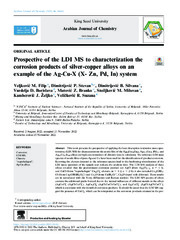Приказ основних података о документу
Prospective of the LDI MS to characterization the corrosion products of silver-copper alloys on an example of the Ag-Cu-X (X- Zn, Pd, In) system
| dc.creator | Veljković, Filip M. | |
| dc.creator | Dimitrijević, Stevan P. | |
| dc.creator | Dimitrijević, Silvana B. | |
| dc.creator | Vurdelja, Borislava D. | |
| dc.creator | Matović, Branko Z. | |
| dc.creator | Stoiljković, Milovan M. | |
| dc.creator | Kamberović, Željko J. | |
| dc.creator | Veličković, Suzana R. | |
| dc.date.accessioned | 2023-01-12T11:13:00Z | |
| dc.date.available | 2023-01-12T11:13:00Z | |
| dc.date.issued | 2023 | |
| dc.identifier.issn | 1878-5352 | |
| dc.identifier.uri | http://TechnoRep.tmf.bg.ac.rs/handle/123456789/5317 | |
| dc.description.abstract | This work presents the perspective of applying the laser desorption/ionization mass spectrometry (LDI MS) for characterization the anode film of the Ag60Cu26Zn14, Ag58.5Cu31.5Pd10, and Ag63Cu27In10 alloys (at high concentrations of chloride ions in solutions). The reference LDI mass spectra of anode films of pure Ag and Cu have been used for the identification of product corrosion. Knowing the clusters detected in the reference spectra lead to the facilitating identification of the LDI mass spectrum of the sample and reduces the analysis time. The LDI MS analysis of these alloys revealed that the predominant corrosion product are AgCl (from AgnCln+1−/+, n = 1–3), and CuCl (from “superhalogen” CumCln− clusters, m = 1–2, n = 2–6); it also revealed Cu2(OH)3Cl (from Cu2(OH)(H2O)2+) and Cu2O (from Cu(H2O)+, Cu2O doped with chlorine). These results are in accordance with the X-ray diffraction and Raman analysis. The LDI MS spectra of alloys contain the additional peaks formed due to the mutual influences of different metals in the alloys (AgCuCl3− (AgCl-CuCl2−), AgCu2Cl4− (AgCl-CuCl-CuCl2−), and Ag2CuCl4− (AgCl-AgCl-CuCl−), which is consistent with the identified corrosion products. It should be noted that the LDI MS suggest the presence of CuCl2, which can be interpreted as the corrosion products retained in the porous films of alloys, and not detected by the other methods due to a small amount. The future theoretical and experimental studies of metal clusters, significant for metallurgy, can contribute that the LDI MS is becoming a powerful analytical tool for characterization the metal surfaces. | sr |
| dc.language.iso | en | sr |
| dc.publisher | Elsevier B.V. | sr |
| dc.relation | info:eu-repo/grantAgreement/MESTD/inst-2020/200017/RS// | sr |
| dc.relation | info:eu-repo/grantAgreement/MESTD/inst-2020/200052/RS// | sr |
| dc.relation | info:eu-repo/grantAgreement/MESTD/inst-2020/200135/RS// | sr |
| dc.rights | openAccess | sr |
| dc.rights.uri | https://creativecommons.org/licenses/by-nc-nd/4.0/ | |
| dc.source | Arabian Journal of Chemistry | sr |
| dc.subject | Ag-Cu alloys | sr |
| dc.subject | Clusters | sr |
| dc.subject | Corrosion | sr |
| dc.subject | LDI MS | sr |
| dc.subject | “superhalogen” | sr |
| dc.title | Prospective of the LDI MS to characterization the corrosion products of silver-copper alloys on an example of the Ag-Cu-X (X- Zn, Pd, In) system | sr |
| dc.type | article | sr |
| dc.rights.license | BY-NC-ND | sr |
| dc.citation.issue | 2 | |
| dc.citation.rank | M21~ | |
| dc.citation.spage | 104461 | |
| dc.citation.volume | 16 | |
| dc.identifier.doi | 10.1016/j.arabjc.2022.104461 | |
| dc.identifier.fulltext | http://TechnoRep.tmf.bg.ac.rs/bitstream/id/13869/bitstream_13869.pdf | |
| dc.identifier.scopus | 2-s2.0-85145652713 | |
| dc.type.version | publishedVersion | sr |

